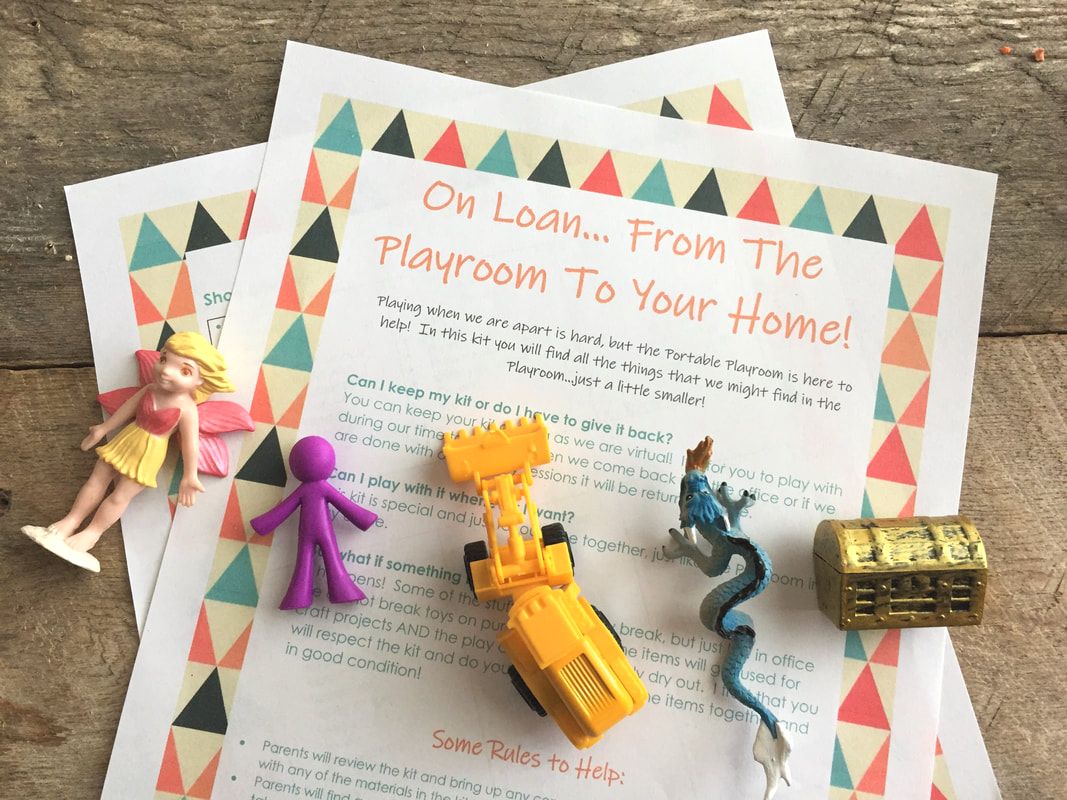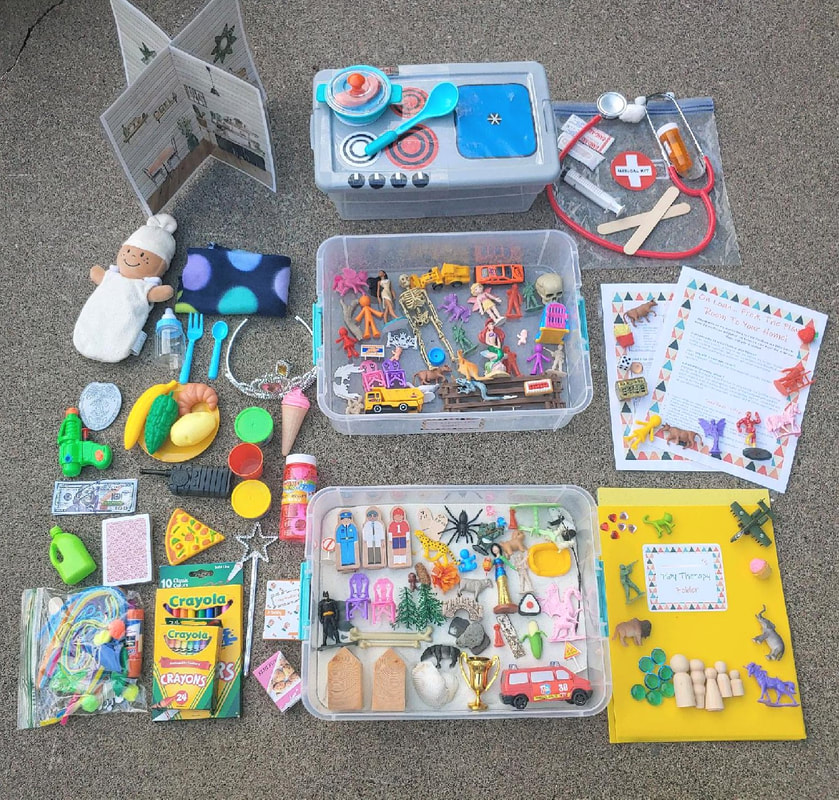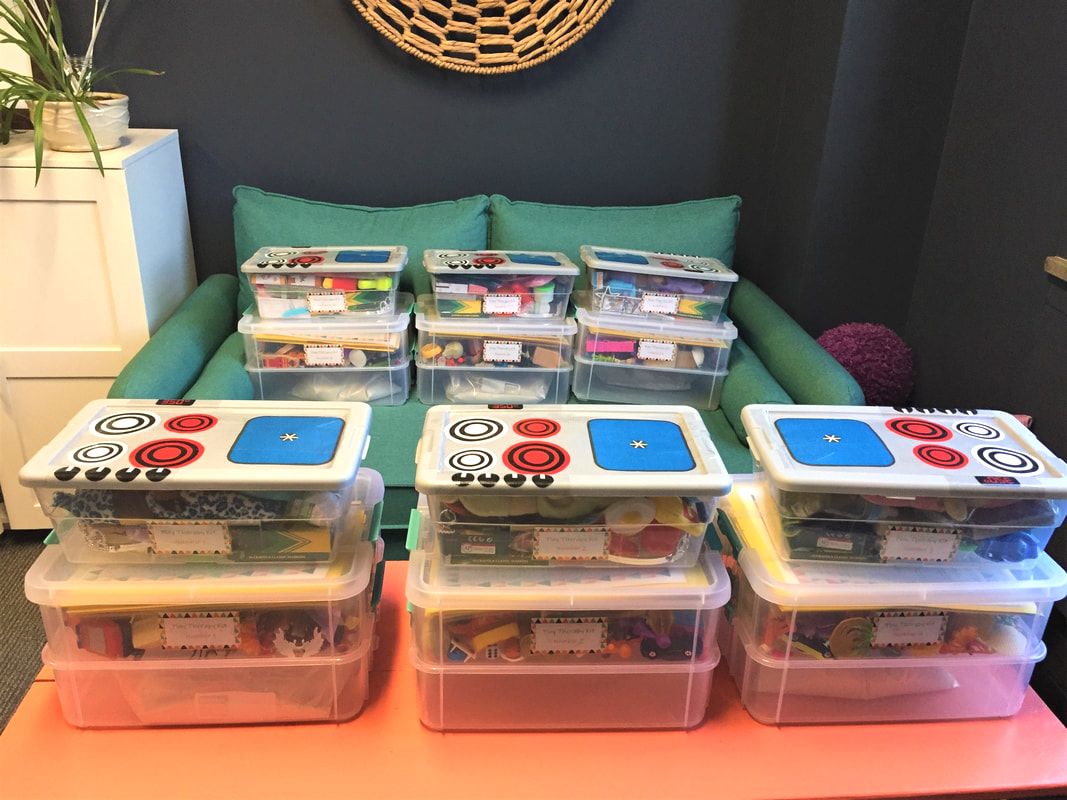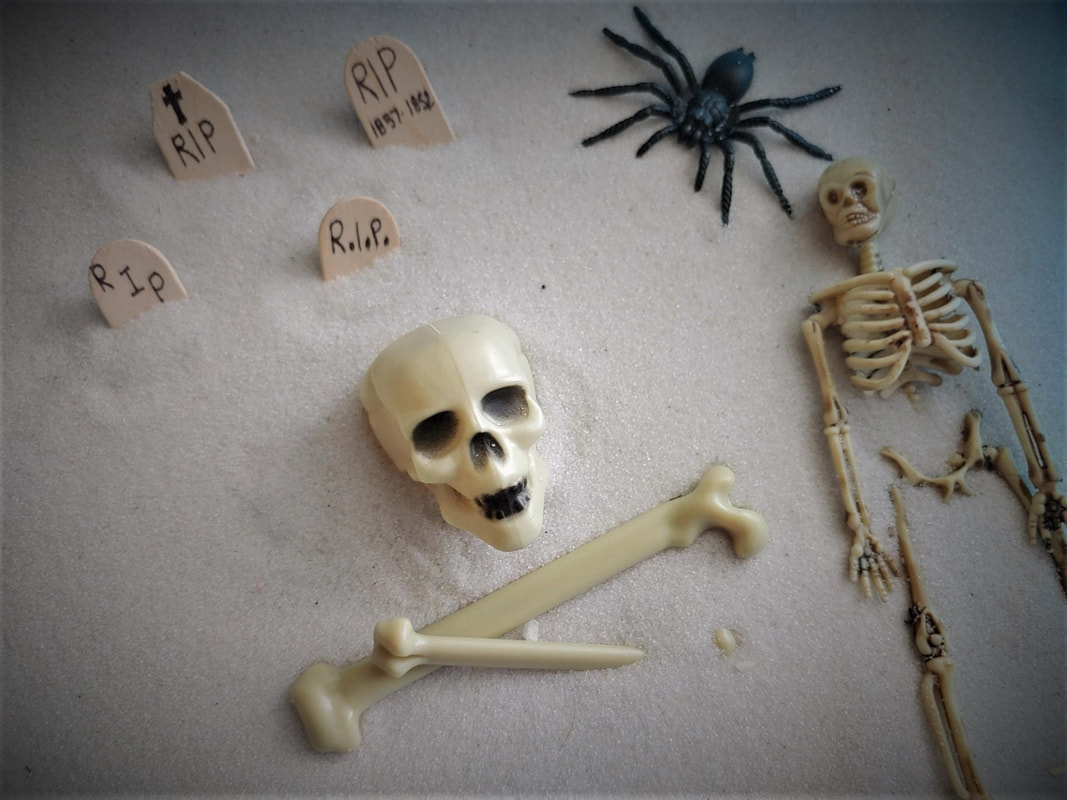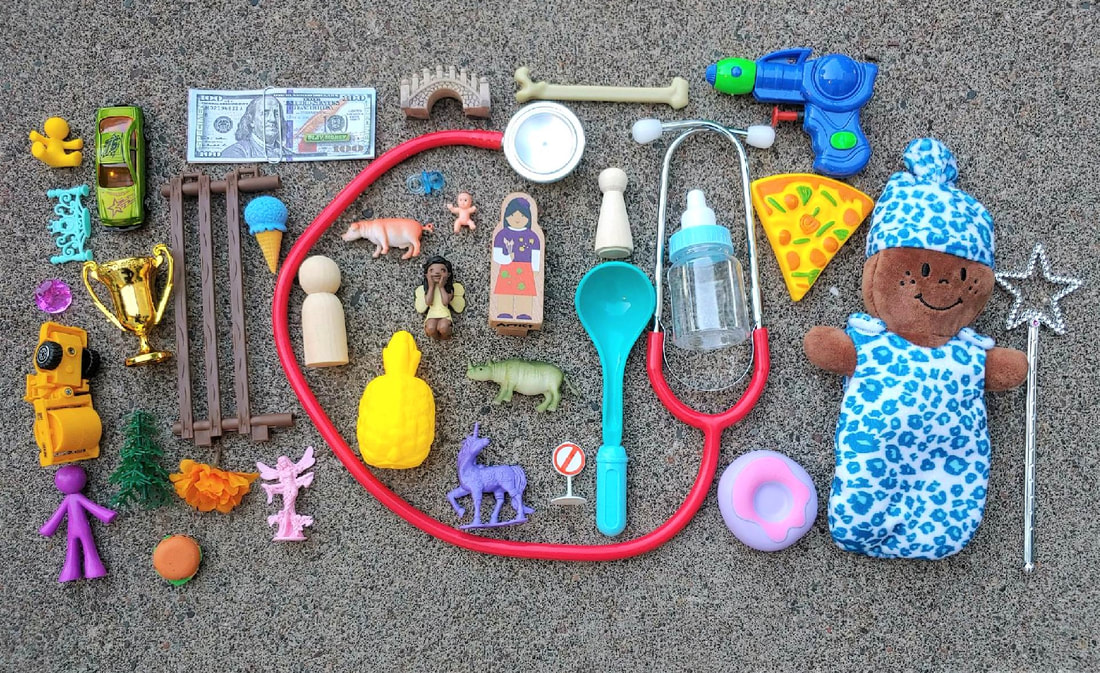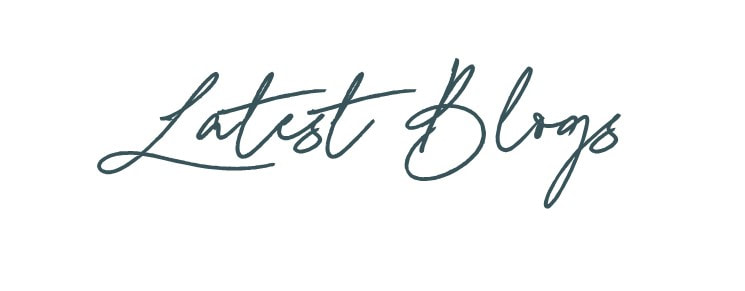|
When creating my Play Therapy Kits for my clients, I wanted to make sure to provide solid structing so children and families knew what to expect and what they could (and could not do) with these kits. I knew I needed to set important boundaries and limits, and at the same time also establish permissiveness. I didn’t want families to feel anxious about holding and keeping the kits AND I didn’t want half of the items to make their way under beds, in personal toy collections, and in couch cushions. This was a lesson learned when some young people got so excited about Play Therapy kits earlier on in virtual work that some of the items got used before the first session. AND I also learned that manila folders (that I sent out my first kits in waaaay back in March) weren’t as durable as I’d like. To create that balance I wanted to express something like…”you may do almost anything with these toys during our time together, but you may not add these toys to your personal collection OR play with them between sessions”. Knowing exactly what to expect and structuring statements are essential for Child Centered Play Therapy and I wanted to carry some of those same principles over to the virtual Play Therapy kit. I wanted these boundaries to re-create some of the things that were unique to my Play Therapy office, such as clients only playing with my specific toys for therapeutic purposes. I wanted to avoid any meaning attached to toys from prior play AND any play that might continue without the safety and security of the Play Therapy relationship. Think along the lines of a client continuing a therapeutic theme after the camera shuts off and a sibling storming in and taking their toys OR a parent or sibling coming in and trying to direct the play. Even though we create rules and structure around this, it seemed to be a lot easier to achieve with the containment of the actual containers and several rules and boundaries about the Play Therapy kits. I came up with three of what I thought the most frequently asked questions parents and children may want to know like “What if something breaks?” and “Can I play with these kits whenever I want?” and gave specific and clear answers. To create permissiveness I detail that just like in the Play Room toys may break, art supplies may get used, and the Play Dough will definitely dry up. Ethically it was also important to me that clients not feel financially tied to the kits. Like if something breaks there is no pressure, need, or expectation to replace anything. Just like if equipment or toys break in the office (and they sure do) it is definitely an expense of doing business and I didn’t want clients (or let’s be honest their parents) to feel responsible in any way if that happened. AND I didn’t want that to trickle down to how they may play with the toys. I also wanted to create an atmosphere of trust and discussed that I trust that clients will take good care of these kits while they are away. I also detailed out items that were included in the kit on the back incase an odd toy turned up here or there, it could make its way back into the kit. Also, for practical reasons, I have a sneaking suspicion I may be keeping these kits for a while (through the pandemic and integrating back into office). It is likely that when clients transition I will need to re-stock kits and this list will help keep me sane regarding what needs to be added back…again definitely the Play Dough. If you want to grab a copy of my Play Therapy Kit Bundle download your free copy HERE! The bundle includes a copy of the parent handout that orients to the kits with some rules, frequently asked questions, and an inventory kit. I laminated mine for durability. I also included a copy of my graphics for numbering my kits AND the stickers I used to label the personal Play Therapy folders! The labels were printed on Avery 15264 Labels (3 1/3'' x 4'') BUT you can also print on paper and just tape onto folders too! I have included both the PDF copies and editable. Sometimes with the editable the format can be off or fonts so make sure you have Century Gothic and Ink Free fonts. Let me know how you are orienting your clients to Play Therapy kits – drop a comment below! Let's Connect - click here to join my email list!
14 Comments
Playing while apart is hard. Playing together with masks and cleaning procedures is hard. Playing is pretty hard in general right now. To make it a teensy bit easier I put together a Portable Playroom In A Tote for my clients to use for play therapy sessions at home. It is a comprehensive play kit that is just a bit smaller than the actual playroom. One that fits in a tote, bag, or rolling suitcase for portability. One of the most frequent questions I get asked by new play therapists is about what toys to buy, most of the time on a budget. It is a struggle as a new play therapist to get a feel for what “should” be in the Playroom while balancing a pretty non existent budget. When it came time for me to start developing Play Therapy Kits for my clients (I talk about the process and pros and cons HERE) I felt like I was starting all over again. I flashed back to my early days of trying to cobble together something that was comprehensive, but feeling very overwhelmed by the 80+ toys that are recommended for Child Centered Play Therapy. Back I went to hours and hours of internet searching, scouring multiple Dollar Tree locations (because not every store has the same darn stuff), and attempting to match, to the best of my ability, the lists and categories of what my young people may need in a portable Playroom. It was definitely a lot of work, but easier this round than last. This kit I created for my clients is pretty comprehensive and includes all categories from Garry Landreth’s categories of toys in his text HERE on Child Centered Play Therapy. Categories of Real Life Toys, Acting Out Aggressive-Release Toys, and Creative Expression and Emotional Release. The kits are also not gendered and they are nearly identical. There is no “boy kit” or “girl kit”, because we don’t want to make assumptions about what a child may or may not need to express themselves. My female identified clients get the scary monsters, army toys, and trucks, and my male identified clients get the dolls, bottles, and princesses. In his text Play Therapy: The Art of The Relationship Garry Landreth also has a toy idea list for a “Tote Bag Playroom”. A lot of those items are included in his kit, however there are many additional items that I selected due to what I find the children I work with are drawn to most. There is also the addition of Sand Tray and miniatures (which represent the categories above as well as Sand Tray categories for miniatures) also making it a larger and more comprehensive kit. Lastly because I also do Cognitive Behavioral Play Therapy I included more directive items such as cards, a dice, stickie hands, and a folder for art and projects. However, as we know those items can also be used to do almost anything a child may want. So without further ado here is the source list for the comprehensive Play Therapy Kits: Containers: Shoe Box Tote *these appear to be out of stock but most Target, Walmart, or Dollar Tree stores carry these for around $1.00. Make sure the top is flat if you are going to create a stove on top. Check out this link HERE for a free printable to turn the top of the shoe box tote into a stove! Sand Tray Tote *If you wanted to only have one tote this would likely fit it all BUT the top isn’t flat enough to be a stove, so if you want a cooking area you might print and laminate a sheet of paper to just sit on top or the floor. Grab a set of free downloadable and printable labels for kits HERE! Orientation Handout: I created a handout to orient parents and children to the Play Therapy kits including frequently asked questions, a list of rules, and an inventory. Grab your free printable (and editable) copy HERE! Sand Tray and Miniatures: Check out this post HERE for a comprehensive list of sources for all the miniatures and sand. I included a dice in the miniature but BUT it is a great took to take out and use for Cognitive Behavioral Play Therapy. Also, if you are transporting the sand tray, store the sand it a Zip Lock bag…trust me. Toy Tote: Dish/Pot and Pan set *these have enough for silverware, a cup, and a plate for 4 kits. They only had a pot/pan for 2-3 depending on what you want in your kits, but the Dollar Tree had a set with a frying pan, egg, knife, and spatula all for $1.00 so I purchase several to supplement. Princess Kit (crown, wand, ring in a 10 pack) *For the price and number of items you get, these were much cheaper than the Dollar Tree, where it was $1.00 for one crown Babies *I LOVE that each of them has an outfit you can take off AND that they are multicultural. When I purchased they were $28.00, so watch out for a sale! The Dollar Tree also has plush multicultural dolls, but they are all female. These come in both gendered/neutral colors and the Dollar Tree ones are in dresses and not infant like. Glue Sticks, Markers, Crayons, Play Therapy Folders – at Target on discount for back to school, the BEST time to refill your art supplies! Baby Blanket *I cut up one yard piece of fleece to make over 10 blankets. You can choose any pattern or hit up a sale at your local fabric store! Doctor Kit (Stethoscope, Syringe (Dollar Tree 4 pack), cotton ball, tongue depressor, band aids (make sure if they are “skin color” all skin tones are represented. If not characters are great!), and medicine bottles. If you are only making one kit a used (empty) medicine bottle from your home or a friend/family member will work great!) Toy Gun Food (9+ items per kit) Play Money *The Dollar Tree also has play money Baby Bottle *these are meant to be party favors but you can get a TON for a great price. I had my husband drill a hole in the nipple of the bottle to make that part less of a choking hazard, even though it is fairly big. You could also hot glue the whole thing together! Printable Doll House *I designed a pop up free printable doll house that I laminated with a bathroom, bedroom, kitchen, and living room. With laminated sheets it is also super wipeable. Stay tuned for the link for the free download! Dollar Tree: Playing Cards (2 pack) Police Kit (badge and walkie talkie) * I choose to purchase these for the walkie talkies but decided to leave out the guns that came with it because although bright orange they appeared a bit too realistic Bubbles (3 pack) Pom poms (multipack) Play Dough (8 pack, 2 per kit) **Check out this post HERE for miniature items that also came from the Dollar Tree Materials from my office: I have a big craft supply at my office so I dug into the stash as well as my treasure chest for these items. Balloons Stickie Hands Pipe Cleaners Popsicle Sticks Googly Eyes Construction Paper 2 Envelopes 2 Paper Bags The Breakdown: Each kit comes in 2 containers, around 170 individual items and cost around $75.00 per kit. The great news about these kits is that I wanted to make them as comprehensive as possible so I did include a lot of stuff. It was an investment I was willing to make in my Play Therapy practice as I knew I would be playing apart for some time, and then when returning to office still likely using the kits for the first bit. Here are some of my kits ready to be picked up by clients! Seriously for how many hours I put into these I felt like I was giving away my first born child (I'm only kind of joking)! But seriously I am hoping this source list saves you a boat load of time if you are thinking about creating these for your clients! Both totes are labeled with numbers (ie Kit 1, Kit 2, etc.) so the matches can stay together and I have a list of what client is in possession of what kit. Also, the awesome thing about this source list is it is so easy to pare down. You can select less to fit your budget. Amazon also has fluctuating prices. Sometimes if you keep an eye on something and come back there will be a sale and discounted pricing. Lastly, if you are making multiple kits you can hit that price point much easier than if you were only doing a single kit, because most come in multi-packs. If you are just starting up and looking for a single kit, pair with other Play Therapists and cost share the price of the kits! Have you started the journey of Play Therapy Kits? What is your most loved item in the kit? Let me know in the comments below! Want to know more about setting up your play therapy office or practice? Check out this training HERE! Let's Connect - click here to join my email list!
Sand Tray is one of my favorite modalities for Play Therapy. When the world came screeching to a halt during COVID-19 I blogged HERE about non-tech ways to do sand tray. Although there are some programs out there that allow you to have a virtual sand tray experience, I could never give up the tactile and kinesthetic value of the sand. In short…I couldn’t leave the sand behind. I wanted to share with you my source list for putting together Play Therapy Kits, and this segment will focus on the Individual Sand Tray Kits I created including all the supplies such as the tray, sand, and miniatures. I talked about the pros and cons of a play therapy kit HERE and how they are great for sending to young people’s homes for Tele-Play therapy, in the office to prevent OR to be honest if you are just starting out in Play Therapy and need a kit that is inexpensive and portable. If I am getting really real here, my office houses carefully selected toys gathered over 10+ years as a Play Therapist and at the end of the day it is a big investment to fully stock a Play Room. Want to know more about setting up your play therapy office? Check out this training HERE! I wish I knew the things I knew now when I was starting about how to gather a comprehensive but inexpensive (I mean inexpensive relative to a fully stocked play room) set of toys and play materials. This was the challenge as I faced the fact that I am not going back into office in the foreseeable future AND was feeling a desire to provide children with the tools needed to express themselves. As I said HERE the families that I work with have done a Rockstar job at gathering appropriate toys, BUT I can’t expect them to have all the toys and categories needed. As Garry Landreth famously said toys are the children’s words, and play is their language. I like to add to this that we need to make sure that we have enough words (ie toys) represented so children can express themselves. I wanted to provide this source list (below) for my sand tray and miniature toys for my Play Therapy Kits. I use categories drawn from this Sandplay text HERE (which is one of my favorite texts) including people, animals, plant life, minerals, environments, transportation, and misc. objects. These minis also fit nicely within Garry Landreth’s categories of toys in his text HERE on Child Centered Play Therapy. The kits are inspired by his paired down version of a playroom in his "Tote Bag Playroom" section! Container: I chose these containers HERE because they could house the sand tray on the bottom and have plenty of room on top for miniatures. The case stacks together with a handled lid on top. I was a bit remiss that the plastic wasn’t blue, but made sure that each kit contained blue vase filler to represent bodies of water if needed. Check out alternative Sand Tray container with 10 Low Cost Options HERE! The Sand: I chose the Sandtastik 25 Lb box, which had enough sand for 8 kits. It's not a TON of sand in each, but enough. Amazon/Target Miniatures:
Dollar Tree Items:
Crafted/Found Items:
So here is the breakdown –each kit contains over 125 miniatures and cost just under $50.00. Although I didn’t base mine on this one HERE, it contains a lot of the same miniatures. However, this one only has 90 miniatures and costs twice the price. I'm a bit biased but I think mine is waaayyyy cooler. The other thing to note is that Amazon's prices can change and although I got some ahhhmazing deals they might not always stay that way! I also bought for multiple kits which made the price significantly less per kit than if I had to buy everything for one kit. So there you have it, the complete source list for a pretty comprehensive sand tray kit for virtual, office, or wherever! What is your favorite miniature that you couldn’t live without? Drop a comment below! Let's Connect - click here to join my email list!
It is the week after Labor Day, which for Minnesota means that it is back to school time. AND that Halloween is right around the corner. Seriously, there was a frost advisory last night. Stores don't lose much time and in between the back to school supplies you will start to see the spooky, scary, Halloween decor pop up! You can almost hear the creepy organ music in the background. I believe that as a Play Therapist you have to learn to be a savvy seasonal shopper to take advantage of all the seasonal deals and offerings as you continue to select items for your play room to create a rich play experience for the children you see. For some of these items I know I will only be able to find them in store (and at a reasonable price) seasonally. Most of the time for me this means browsing the seasonal sections, the dollar spot, and the Dollar Store/Dollar Tree, and man, did this season deliver! So, some pro tips I want to share with you are that not all Dollar Stores are created equal. Sometimes one will have a huge selection of items, and the next will have just a few. There is also some items that will be offered at one store, but not the next. AND the frustrating part is if you order online you need to purchase a minimum number and a lot of items are not offered online. The other tip is that sometimes, placement just doesn’t make sense. Two of these items I found back on an end cap by the freezer section, not at all by the seasonal display. Don’t give up, keep looking! Okay, so let’s dive in to some of my favorites from this season. All of these items came from the Dollar Tree and one was created. The bones came in a 10 pack (5 large, 5 small), the skulls were an 8 pack, and the skeletons were actually a part of skeleton garland. Once you cut those little guys free you had a set of 4 miniatures. Also, if you don't already have this is the PERFECT time to pick up some spiders and creepie crawlies! So….that’s 22 minis for a whopping $3.00 – pretty cool huh? These were really great and affordable for me as I am putting together my Play Therapy kits. If you don’t need all these minis for your play room or sand tray then I suggest you get a mini buddy or have a mini exchange. A mini buddy is a Play Therapist that LOVES to select and gather items for their play room where you can split the cost of multi-packs of items between two or more therapists. A mini exchange is where each therapist brings a similar priced piece/pieces of a set and you swap, walking away with new items for your Play Room! The last item is those mini grave stones. I’m going to be really honest… I love these ones HERE, but couldn’t quite get myself to commit for the kits I am creating and wanted to keep it as low budget as possible. Enter the 500 Popsicle sticks I have currently in my stash. They cut SUPER easily with regular scissors and I decided to make them in various heights. This is like the simplest version of writing on them directly with a fine tipped sharpie marker. If you have time the sky could be the limit with painting or creating designs! Don’t worry, I’ll be adding those beeeautiful stones from Amazon to my collection eventually, but it’s all about pace! So why is it important to grab these little minis while you can? I mean, besides the fact that they are So. Much. Fun. Death and dying miniatures (especially if you do sand tray) play an essential and crucial role in helping children express their inner most thoughts and feelings in the tray and in the Playroom. If I reflect on how my current collection of death and dying objects are used there is a lot of pain, meaning making, closure, empowerment, and processing that is done. Wheeww heavy stuff right? What are your favorite deals for this fall and Halloween season? Where are you shopping? Drop a comment below! Let's Connect - click here to join my email list!
The challenge: fit an entire play room into a small kit and make it cost effective enough where you can afford to create multiple different kits. This has been on my mind since the start of summer, where I ebbed and flowed between safety, in office vs. virtual, and having the right tools to effectively do my job. Here is a peek at a fraction of how I am coming along with this challenge and what I am incluidng in these kits! As I am assembling these kits I am LOVING opening the package and so far, everything fits *fingers crossed*. So why play therapy kits? I talked HERE about children’s imagination and creativity in toy selection, BUT I was starting to wonder that for kids that are doing Tele-Play 100% of their sessions, if there was something unique, special, and magical about toys specifically selected by a play therapist. Toys that are unfamiliar and toys that they do not have any history with. Now, the families that I work with have been absolute CHAMPIONS for selecting toys by Garry Landreth from this list available HERE from the University of North Texas. However, over time the toys have begun to get a bit scattered or sometimes there are important figures or object the child just didn’t have. I’m going to be really honest. When everything shut down, I transitioned my toys and materials home, set up my garage office, and began to prepare my clients for all virtual sessions. I thought “yea, I can do this for three or for weeks”. HA. HAHAHAH. Thank goodness that was my thinking because I think if I understood what was to come the overwhelm would have left me paralyzed. I now look at this thinking as a humorous gift. I also want to emphasize that there is no one right way when you are thinking about continuing your work as a therapist who serves children. For me, the best thing that I can do for my clients is to continue virtual for the foreseeable future. I do not have any outdoor space at my office (6th floor!) AND with being a Minnesotan – winter is coming. I have also pondered the experience of play therapy with distance and a mask and am unsure if I will stay regulated enough if a client has told me about a large gathering they attended or being back in a classroom to be attuned and regulated as they need me to be. And as for me, ethically I have pondered that if I come into contact with someone who is being tested (which has happened for me or someone coming through our office, and inevitably will keep happening) do I then transition to virtual sessions until the results come back? What will that transition be like for my clients? And others…well other therapists out there are mandated by agencies or schools to be back in person OR they have made the choice that in person is what is best for the treatment of their clients. With this option comes the cleaning, sanitizing, outdoor sessions, masks (and the hunt for the perfect mask that is clear and doesn’t fog!) and other safety measures like researching UV light sanitizing. Ugh. Enter the Play Therapy Kit. As I have started the process of building play therapy kits, my intention is to send them out to some of my clients who need more or who have struggled with play with the toys they have in their own collections. Also when taking on new clients I want the transition to play therapy to be seamless so some of the kits will go to new young people on my caseload. I have been sharing some of my projects for the transition around the blog with my nearly free (with free printable) compact play kitchen HERE and low cost options for sand trays for sand tray kits HERE! I actually think play therapy kits are an awesome solution for both virtual and in office! The goal for the Play Therapy Kit is to have a comprehensive “play room” in a very small and portable kit so you can either send them to families OR have them in your office for children to use. In office (or if you are between multiple offices or schools) you would either assign a child to a specific kit and have that child be the only one to play with that kit (I'm going to number mine) OR have only one kit used per client per day and sanitize them all at the end of the day. For example if you had 5 play therapy clients scheduled for the day then each would select a different kit (all with identical items) and then that kit would be put aside to be sanitized at the end of the day. Play Therapy Kit Pros: The biggest pro for me (with sending kits to kids) has been making sure they have a comprehensive set of toys to access for our sessions. Some of the most impactful and meaningful work virtually has come when I had children create and play with modified sand trays, like I talk about HERE. These kits would help young people do Sand Tray work, if needed, AND open up the world to things that they may not have available at home. I also have wondered if play therapy is different with toys they have never seen before and have no prior emotional connection to. I also felt like for virtual play, these kits offered significantly more containment ability (snapping lids). Lots of my families stored sand trays open, toys in tote bags, etc. and the ending of the play therapy session just didn’t quite feel like the process of in office. And by “containment ability” I was definitely more interested in visual and emotional containment rather than the actually cleaning up of toys for practical reasons, but for both it is a big pro! Another pro with the kits (for in office) is that it lessens the burden on cleaning between clients. For me when I was in office before things shut down, I cleaned and sanitized between sessions. Even thought I had a designated “used toy” tote to place items rather than back on the shelf, I felt that practice was limiting. I had young people who would dig through my miniatures (of course I couldn’t track the exact things they touched) and then I would have to sanitize ALL the contents of several bins. *face palm* Inevitably they would forget the rules and put things back on shelves, and I found myself constantly reminding or limit setting. This seemed restrictive to the permissiveness play therapy is supposed to offer. It also left a really strong odor of cleaning supplies in between sessions. I also found when we only took out several objects at a time it felt restricting to the permissiveness of play therapy as well. With kits the limits seem significantly clearer – we can play with anything we want to in your play therapy kit! AND since the kits are comprehensive it doesn’t feel like they are limited to the types of things that they may play. Another pro is that these kits are small enough where they can be easily stored by parents in home and don’t take a significant amount of muscle to take out, carry, or transport. If you are going between offices these would fit nice in a tote bag or a rolling suitcase. If you are transporting between office be sure to Zip Lock Bag your sand…trust me on this one. Play Therapy Kit Cons: The first con is that to get a comprehensive kit they can be spendy, even when you are cutting costs and creating the most cost effective kits possible. After all the dust settled I was around $60 - $70 per kit, which is a small tiny fraction of what it takes to create a standard play room. However, with 8 kits that I have created (with this round) it was a pretty big chunk of change. AND anticipating they would be used at least for the next 6 ish months, likely more if you count the transition back to office, it seemed like a solid investment for my practice. You could absolutely decrease the number of kits made and then you would only need to sanitize one time per day or in the middle of the day, rather than between every client. Other cons include the time to create and make these kits. I have spent TONS of hours scoring the internet, at Target, and the Dollar Store, to get ideas, cost compare, and purchase all of the supplies. Within the next weeks I will be sharing my entire source list – SO hopefully it makes it easier for you! However, you still will put a large amount of time in, especially if you are making the play stove kits. So. Many. Circles. Another downfall is storage. A pro for portable and at home, but if they are all stored in your office, these kits will need space and you may need to rearrange your regular toys to make room. You may also need to remove certain toys or all other toys, as to not have to put excessive limits on what can be touched and what can’t. Now, there are some things that won’t fit in the little kits. Think pool noodles (some of my favorites!). When I go back into office I am anticipating developing a small selection of toys (including the pool noodles) that can be touched by any child but are really easy to sanitize between sessions. Meebie might go into this category (with fabric sanitizer of course). However, depending on how these kits roll out, I may do individual pool noodles that sit on the shelves with the toy kits! Lastly, if you are virtual the other con to this is getting the play room from you, to your client. A great option is pick up at the office location (mine is still open with admin for therapist that choose to be in person or do virtual from the office). The second way is shipping the kits, however that can definitely get costly to ship even one play therapy kit. Play Therapy Kits won’t be for everyone – but maybe they will be right for you! Hopefully this introduction to the play therapy kit has got your brain going about whether this would be a good fit for your play therapy practice as we keep playing on in this pandemic! Have you already created kits of your own? Drop a comment or link to your favorite toys that are MUST for inclusion! Let's Connect - click here to join my email list!
|
Hi, there!I'm Ann Meehan, an LPCC, Loading... Archives
July 2024
Categories
All
|
Privacy Policies | Terms of Use | Disclaimer
Contact
[email protected] | Copyright Meehan Mental Health Services 2022
Contact
[email protected] | Copyright Meehan Mental Health Services 2022

